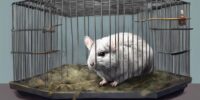What Are the Social Hierarchies Like in Wild Parrot Flocks?
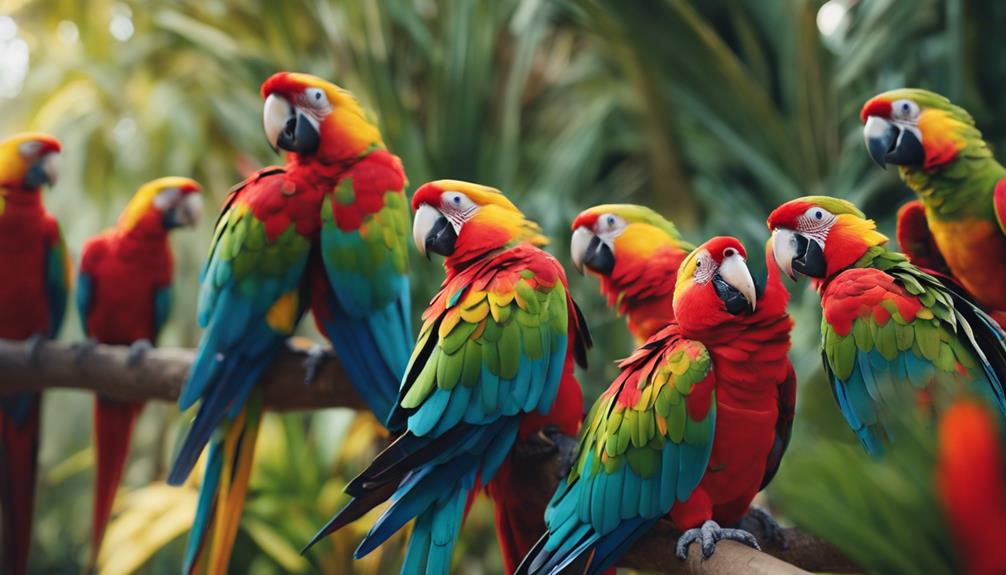
Social hierarchies in wild parrot flocks play a crucial role in determining group dynamics and interactions among individuals. Dominance within these flocks is often established through aggressive behaviors and vocalizations, with higher-ranking individuals having priority access to resources such as food and mates. Communication is key in maintaining social order, with parrots using a diverse range of vocalizations and body language to convey messages and maintain group cohesion. Cooperation among flock members is also essential for tasks such as foraging and predator defense, with individuals working together to ensure the safety and well-being of the group.
Understanding the intricacies of social hierarchies in wild parrot flocks can provide valuable insights into the evolution of avian communities and the ways in which individuals interact within these complex social structures. By studying dominance, communication, and cooperation in parrot flocks, researchers can gain a deeper understanding of the mechanisms that govern social behavior in birds and shed light on the factors that contribute to the success and survival of these fascinating avian communities.
Social Structure of Wild Parrot Flocks
Observing wild parrot flocks reveals a complex social structure characterized by hierarchical relationships among individual birds. Within these flocks, feeding habits play a crucial role in shaping the dynamics. Parrots often exhibit cooperative feeding behaviors, with dominant individuals having priority access to food sources. This can lead to competitive interactions, especially during times of scarcity, where lower-ranking parrots may struggle to secure sufficient nutrition.
Roosting patterns also contribute significantly to the social structure of wild parrot flocks. Parrots tend to roost together in large groups, with specific individuals or pairs taking up central or elevated positions within the roosting site. These prime locations offer advantages such as increased safety from predators and better access to potential mates. Dominant parrots usually claim these preferred spots, further solidifying their higher status within the flock.
Understanding the interplay between feeding habits and roosting patterns provides valuable insights into the social dynamics of wild parrot flocks, highlighting the importance of cooperation, competition, and hierarchy in shaping their behavior.
Dominance Hierarchy Among Parrots

Within wild parrot flocks, a clear dominance hierarchy emerges, shaping social interactions and behaviors among individual birds. This hierarchy plays a crucial role in maintaining order and reducing conflicts within the flock.
Key Observations:
- Food Competition: Dominant parrots often have priority access to food sources within the flock. They may assert their dominance during feeding times, leading to submissive behavior from lower-ranking individuals. This ensures that the most dominant birds receive adequate nutrition, which is crucial for their survival and reproductive success.
- Vocal Interactions: Vocalizations play a significant role in establishing and maintaining the dominance hierarchy among parrots. Dominant individuals may use vocal signals to assert their authority and communicate their status to others in the flock. Subordinate birds, in turn, may respond with quieter vocalizations or avoid direct eye contact to display submission.
- Behavioral Patterns: Dominant parrots exhibit more confident and assertive behaviors compared to their subordinate counterparts. They may engage in displays of dominance, such as puffing up their feathers or engaging in physical interactions, to reinforce their status within the flock. Subordinate birds, on the other hand, often display more submissive behaviors to avoid conflicts with higher-ranking individuals.
Communication Dynamics Within Flocks
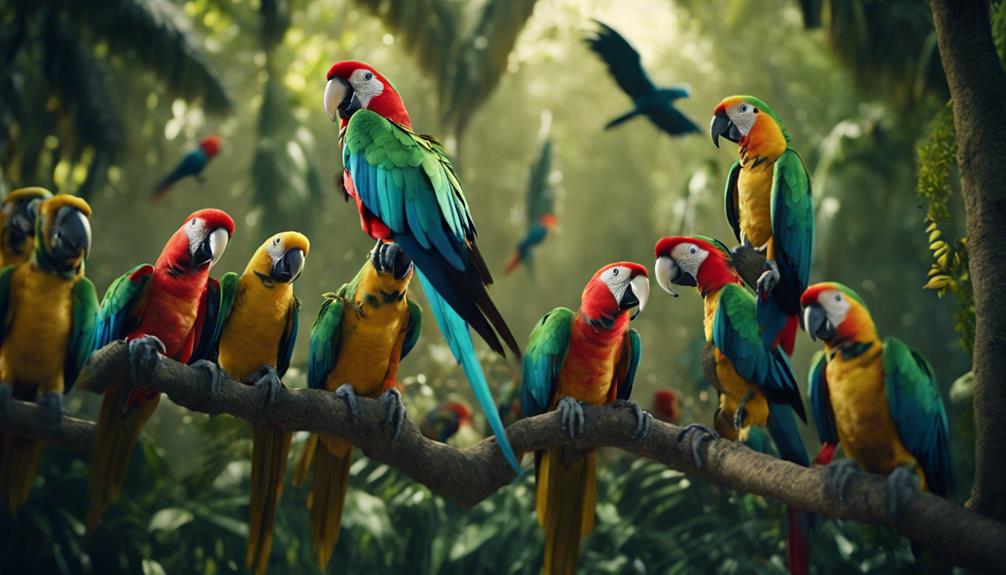
Communication dynamics in wild parrot flocks play a crucial role in shaping social interactions and maintaining cohesion among individuals. Vocal interactions are a fundamental aspect of parrot communication within the flock. Parrots use a diverse range of vocalizations to convey messages such as warning calls, mating calls, and territorial disputes. These vocal signals help establish hierarchies and coordinate group movements, contributing to the overall cohesion within the flock.
Feeding behaviors also play a significant role in communication dynamics among wild parrot flocks. Parrots often exhibit cooperative feeding behaviors, where individuals work together to locate food sources and signal others in the group. These feeding interactions not only promote social bonding but also help distribute resources more efficiently among flock members.
Role of Age in Social Hierarchies
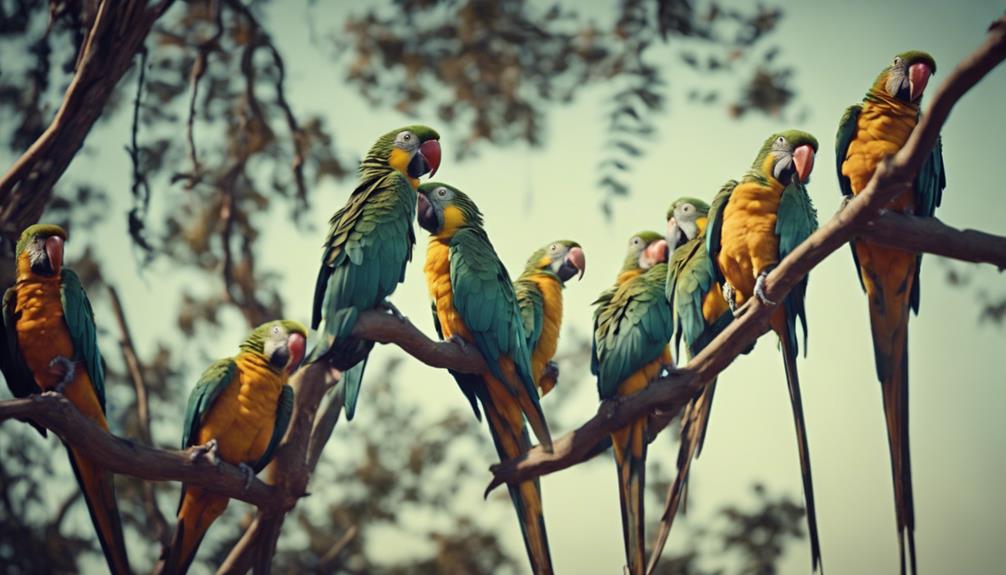
Age plays a crucial role in shaping social hierarchies within wild parrot flocks. Older parrots often exhibit dominance over younger individuals, establishing themselves as leaders within the group.
Despite their lack of experience, younger parrots can also influence the flock's dynamics and gradually climb the social ladder as they mature.
Age and Dominance
Observations within wild parrot flocks reveal a clear correlation between age and dominance in shaping social hierarchies.
Key Findings:
- Seniority: Older parrots often hold higher positions within the flock's dominance hierarchy, commanding respect from younger members.
- Experience: With age comes experience, allowing older parrots to better navigate social interactions and assert their dominance effectively.
- Teaching Role: Elder parrots may take on a mentorship role, guiding younger members in social behaviors and reinforcing the hierarchical structure.
These dynamics highlight the importance of age-related behavior in determining the social order within wild parrot flocks. Understanding the role of age in dominance can provide valuable insights into the intricate social dynamics of these avian communities.
Leadership Among Elders
Elder parrots in wild flocks often demonstrate a pronounced influence on the group's social dynamics, exerting significant authority and guidance within the hierarchy. Their elder wisdom and distinct leadership styles play a crucial role in maintaining group cohesion and ensuring the flock's overall well-being. Age dynamics within the flock are essential as older parrots command respect due to their experience and knowledge. Observationally, elders are seen making decisions for the group, settling disputes, and leading the flock to food and water sources. This leadership among elders fosters a sense of security and stability within the flock, contributing to the overall success of the group. The table below further illustrates the importance of leadership among elders in wild parrot flocks.
| Leadership Among Elders | Role in Flock Dynamics | Impact on Group Cohesion |
|---|---|---|
| Elder Wisdom | Guidance and Authority | Strengthens Bonds |
| Leadership Styles | Decision-making | Promotes Unity |
| Age Dynamics | Respect and Experience | Ensures Stability |
Young Parrots' Social Status
Young parrots in wild flocks assert their social status through intricate interactions and behavioral displays that reflect their position within the hierarchy.
- Juvenile Interactions: Juvenile parrots often engage in playful activities and mimicry, which serve as crucial means for social learning and developing hierarchical understanding within the flock.
- Adolescent Challenges: As young parrots transition into adolescence, they may face challenges in navigating group dynamics, such as finding their place within the hierarchy and establishing relationships with older flock members.
- Group Dynamics: Young parrots play a vital role in shaping the overall dynamics of the flock by testing boundaries, forming alliances, and learning from their interactions with both peers and older individuals.
Gender Roles in Parrot Flock Behavior
Male parrots are often observed engaging in elaborate courtship displays, showcasing their vibrant plumage and vocal abilities to attract females.
On the other hand, female parrots exhibit distinct nesting behaviors, meticulously selecting and preparing nesting sites to ensure the safety of their offspring.
Once the eggs are laid, a clear division of parental care emerges, with males and females taking on specific roles in feeding, protecting, and nurturing the young.
Male Courtship Displays
During courtship displays within wild parrot flocks, individuals exhibit distinct behaviors that play a crucial role in establishing social hierarchies and mate selection.
Key Aspects of Male Courtship Displays:
- Plumage Coloration: Male parrots often showcase vibrant plumage colors during courtship displays to attract potential mates. Bright and striking colors signal genetic fitness and good health, making the male a desirable partner.
- Mating Rituals: Male parrots engage in elaborate mating rituals, which can include intricate dances, vocalizations, and displays of agility. These rituals serve to impress females and demonstrate the male's suitability as a mate.
- Territorial Disputes and Rival Displays: Male parrots may engage in territorial disputes with rival males, showcasing dominance through aggressive behaviors or elaborate displays to secure mating opportunities and establish their status within the flock.
Female Nesting Behavior
Female parrots in wild flocks demonstrate intricate nesting behaviors that reflect their vital roles in the social dynamics and reproductive success of the group.
Nesting rituals among female parrots involve selecting suitable nesting sites, building nests using twigs, leaves, and other materials, and engaging in elaborate courtship displays to attract mates.
Once the nest is constructed, female parrots carefully lay their eggs and take on the responsibility of egg incubation. This process is crucial for ensuring the survival of the offspring, as proper incubation helps maintain the optimal conditions for egg development.
Female parrots exhibit remarkable dedication during this period, diligently safeguarding the eggs until they hatch. These nesting behaviors highlight the essential contribution of females to the reproductive success and sustainability of wild parrot flocks.
Parental Care Division
Building on the intricate nesting behaviors observed among female parrots, the division of parental care within wild parrot flocks reveals distinct gender roles that contribute to the overall reproductive success and social structure of the group.
- Parental Involvement: Female parrots typically take the lead in providing direct care to the offspring, including feeding, grooming, and protecting them from potential threats.
- Communication: Male parrots play a crucial role in defending the nest and foraging for food, maintaining constant communication with the female partner to ensure the safety and well-being of the family unit.
- Nesting Behaviors: The division of labor in parental care showcases a harmonious balance between male and female roles, emphasizing the collaborative nature of raising young parrots in the wild.
Impact of Environmental Factors
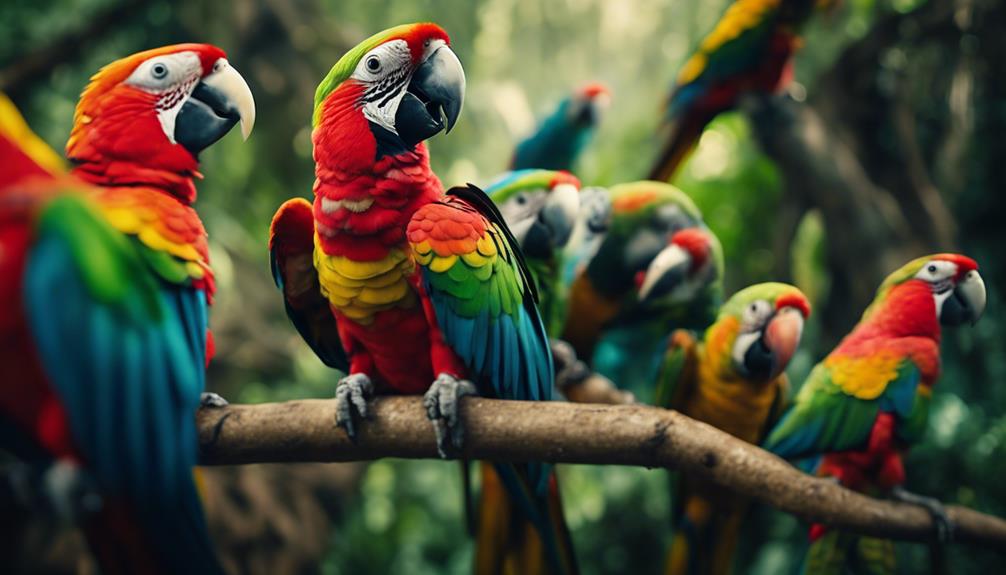
Environmental factors play a significant role in shaping the social hierarchies observed within wild parrot flocks. The environmental influences directly impact the social behavior of parrots, affecting their hierarchy dynamics. For instance, climate impact plays a crucial role in determining the availability of resources like food and nesting sites. In times of scarcity, parrots may exhibit more aggressive behaviors towards each other as they compete for limited resources, leading to shifts in the hierarchy. Conversely, during periods of abundance, the hierarchy might be more stable, with less aggression observed among flock members.
Moreover, environmental factors such as habitat type and size can also influence hierarchy dynamics. Parrot flocks in larger, more diverse habitats may have more complex social structures compared to those in smaller, uniform environments. These variations in environmental conditions shape the interactions among flock members, ultimately impacting the establishment and maintenance of social hierarchies within wild parrot populations. Understanding these nuances is crucial for comprehending the intricate social dynamics of wild parrot flocks.
Challenges to Hierarchical Order
The stability of social hierarchies within wild parrot flocks faces various challenges that stem from dynamic interactions among flock members and external factors.
- Behavioral challenges: In wild parrot flocks, behavioral challenges can arise when individuals exhibit unexpected or aggressive behaviors that disrupt the established social order. For example, a parrot may challenge the dominant bird for a preferred nesting site, leading to conflicts within the flock.
- Power struggles: Power struggles among parrot flock members can occur when individuals vie for control over resources such as food, mates, or nesting sites. These power struggles can result in shifts in the hierarchical order as birds assert their dominance or challenge the authority of others.
- Environmental disruptions: External factors like changes in food availability, habitat destruction, or human interference can also pose challenges to the hierarchical order within wild parrot flocks. These disruptions can lead to increased competition among flock members, affecting their social dynamics and hierarchical structure.
Frequently Asked Questions
How Do Parrots Establish Their Social Status Within a Flock?
In the wild, parrots establish social status through vocal dominance and body language. For example, in a case study, parrots with louder calls and more confident postures often lead the flock, influencing nesting behavior and feeding patterns.
Are There Any Specific Rituals or Behaviors That Parrots Use to Maintain Their Dominance Hierarchy?
In wild parrot flocks, dominance rituals play a crucial role in maintaining social order. Behavioral cues such as vocalizations, body language, and physical interactions help establish and reinforce the hierarchy within the group.
Do Parrots of Different Ages Interact Differently Within the Flock's Social Structure?
In wild parrot flocks, age dynamics play a crucial role in shaping interactions. Younger parrots learn from elders through communication and observation. Leadership roles form based on experience, fostering bonding and ensuring the continuity of knowledge within the flock.
How Do Environmental Factors, Such as Food Availability or Predator Presence, Affect the Social Hierarchies of Wild Parrot Flocks?
Environmental factors such as food availability and predator presence significantly impact the social hierarchies of wild parrot flocks. Resource competition influences group dynamics and leadership roles, while communication signals play a crucial role in maintaining order within the flock.
Are There Any Known Instances Where Parrots Challenge or Disrupt the Hierarchical Order Within Their Flock?
In wild parrot flocks, instances of dominance challenges and disruptive behavior can occur, impacting the established social order and flock dynamics. These occurrences provide insights into the complex interactions shaping hierarchical structures within parrot communities.





